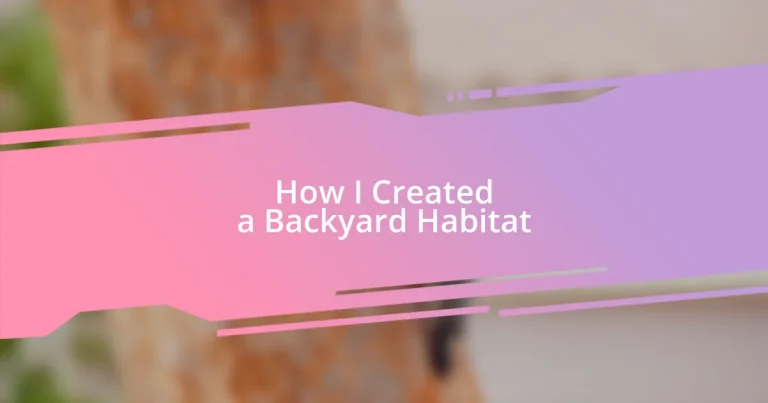Key takeaways:
- Creating a backyard habitat enhances local wildlife support, promotes biodiversity, and provides emotional benefits through a deeper connection with nature.
- Selecting native plants and adding water sources are essential steps that attract diverse species and create a vibrant ecosystem.
- Ongoing maintenance, including monitoring invasive species and engaging with wildlife, is crucial for sustaining a healthy backyard habitat.
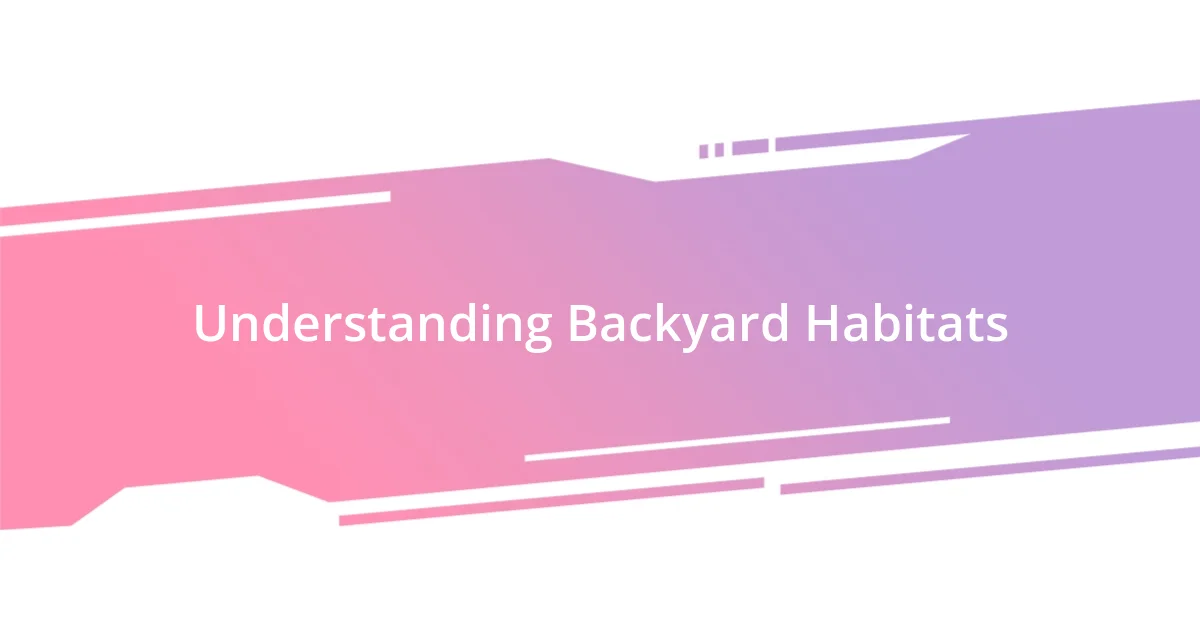
Understanding Backyard Habitats
Backyard habitats are like living tapestries woven from the interplay of plants, animals, and the elements. When I first decided to create a habitat in my own backyard, I was surprised by how many different species found their way into my little oasis. Have you ever stopped to wonder just how much life is buzzing around your garden?
I remember the joy of spotting a family of rabbits munching on the clover while butterflies danced around the flowers I carefully planted. Each day, I discovered new visitors, from curious squirrels to bright cardinals. It really struck me how our backyards can be treasure troves of biodiversity, and I’m convinced that we can all play a role in nurturing that diversity.
Creating a backyard habitat doesn’t require a degree in ecology; it just takes a bit of curiosity and commitment. Imagine setting up a small birdbath or leaving a corner of your garden wild—what kind of surprises might await you? Each little change can lead to amazing wildlife encounters, deepening our connection to nature right in our own spaces.
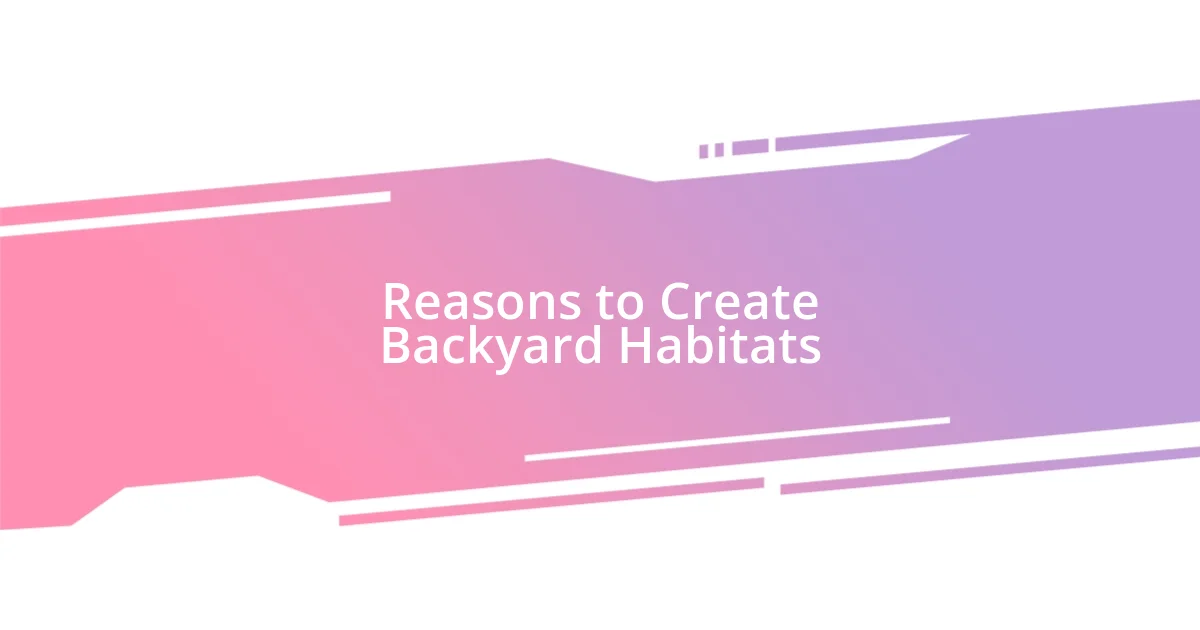
Reasons to Create Backyard Habitats
Creating backyard habitats is not just about beautifying our spaces; it’s an emotional and transformative experience for both the environment and ourselves. I remember the first time I saw a hummingbird hovering at my homemade feeder, and in that moment, I felt an incredible sense of connection to nature. It’s rewarding to witness the tiny ecosystems thriving right outside your door, revealing the intricate tapestry of life that surrounds us.
Here are a few reasons why I believe backyard habitats are so valuable:
- Support Local Wildlife: Providing food, water, and shelter helps sustain local animals.
- Promote Biodiversity: Diverse plant life encourages a variety of species to coexist.
- Enhance Aesthetics: A vibrant habitat adds beauty and character to your outdoor space.
- Foster Educational Opportunities: Observing wildlife can be an excellent learning experience for children and adults alike.
- Stress Relief and Well-being: Spending time in nature has proven mental health benefits and promotes relaxation.
By creating a habitat, you’re not only contributing to the planet’s health but also nurturing your own spirit. Each familiar chirp or rustle of leaves becomes a calming reminder of the beauty that exists when we let nature flourish.

Choosing the Right Location
When it comes to choosing the right location for your backyard habitat, I can’t stress enough the importance of sun and shade. I found that a spot that receives morning sunlight but is shaded in the afternoon created a perfect balance. This setup not only kept the soil from drying out but also attracted a variety of birds, making my habitat lively and full of movement.
Another aspect I’ve learned through experience is considering accessibility. It’s crucial to have paths that allow you to wander and enjoy your habitat while keeping it easy to maintain. I remember clearing a small trail through my garden, which became my favorite spot to sip coffee and observe the happenings around me. It’s these small tweaks that can transform your habitat into a personal sanctuary, making your connection to nature even stronger.
Lastly, think about proximity to water sources. Having a small pond or even a birdbath nearby can significantly enhance the diversity of wildlife you attract. After I added a tiny water feature, I was delighted to see frogs and dragonflies making it their home. Who would have thought such a simple addition could bring so much life to my backyard?
| Factor | Considerations |
|---|---|
| Sunlight | Morning vs. afternoon sun affects plant growth and wildlife activity. |
| Accessibility | Paths enhance enjoyment and maintenance of the habitat. |
| Water Sources | A small pond or birdbath attracts diverse wildlife. |
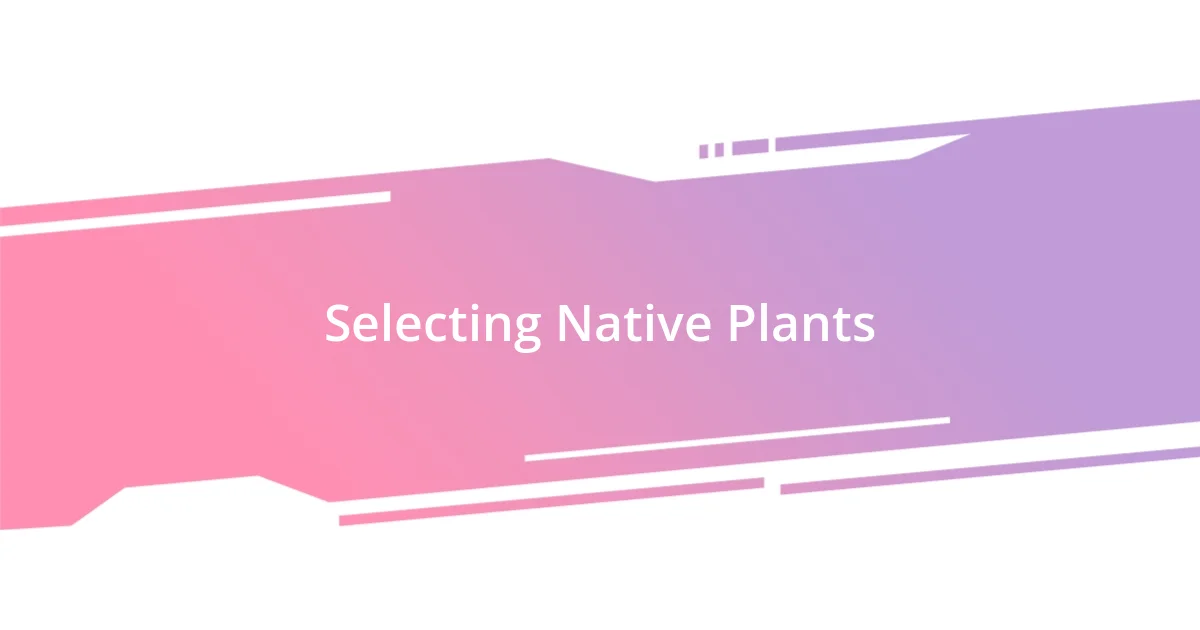
Selecting Native Plants
Selecting native plants for your backyard habitat can feel like embarking on a personal adventure. I remember walking through my local nursery, overwhelmed by the colorful options before me, and realizing that native plants could offer so much more than mere aesthetics. Choosing flora that thrives in your region not only supports local wildlife but also creates a sustainable garden that requires less maintenance. Isn’t it freeing to think about a garden that works with nature rather than against it?
When selecting native plants, consider the specific wildlife you want to attract. In my experience, I noticed that by planting milkweed, I could entice monarch butterflies into my space—a sight that brought me immense joy and amazement. It’s fascinating how certain plants have evolved alongside particular species, making them the perfect food source and habitat. This knowledge transforms your garden into a vibrant ecosystem filled with life, but it also invites a deeper connection with the environment around you.
I found that incorporating a mix of flowering plants and ground covers could create layers in my garden and provide shelter and food for various creatures. You might think, how can something as simple as a flower impact wildlife so much? Well, I discovered that each bloom serves as a tiny buffet for bees and butterflies, while the dense foliage below provides safety for small animals. Watching this intricate interaction unfold was a reminder of the tremendous impact of thoughtful planting.

Adding Water Sources
Adding water sources to your backyard habitat was a game changer for me. Initially, I placed a simple birdbath in the center of my garden, thinking it would just look pretty. But the moment I saw birds flitting in and out while sipping water and splashing around, I felt an overwhelming sense of joy. It was like my garden had come alive with their vibrant energy, and I couldn’t believe how such a small addition could have such a huge impact.
I also decided to create a small pond that not only acts as a water source but also a beautiful centerpiece. The first time I spotted a family of ducks waddling over for a swim, my heart swelled! It’s moments like these that remind me of the incredible connections we can foster with nature. Plus, the reflective surface of the water creates a serene atmosphere that’s perfect for relaxing or reading a book—two of my favorite activities.
In my experience, maintaining the water sources is key to ensuring they attract wildlife. I regularly change the water in the birdbath and keep the pond clean to prevent algae buildup. Have you ever noticed how stagnant water seems to repel life? A little effort goes a long way. When the water is fresh and inviting, I often see not just birds, but also butterflies and even the occasional curious raccoon. Each visitor adds a new layer of excitement to my habitat, making the effort truly worth it.
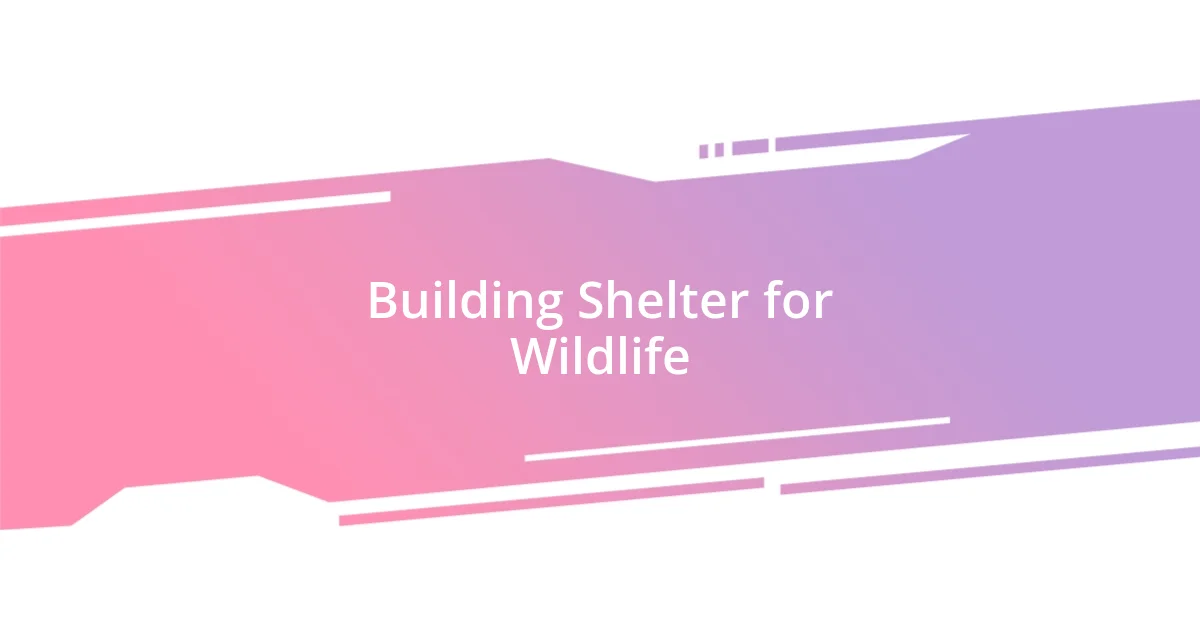
Building Shelter for Wildlife
Building a shelter for wildlife in your backyard opens up a realm of possibilities. I constructed a small log pile in a shaded corner using branches I collected during yard clean-up. Watching the first chipmunk peek out from under the logs filled me with a sense of fulfillment. Who knew that creating a simple refuge could provide such joy? It’s incredible how a few logs can transform into a cozy home for creatures seeking safety.
I also dedicated a corner of my garden to a brush pile. At first, it felt like a bit of a mess, but I quickly learned that this untamed space is a treasure trove for birds and small mammals. The thrill I felt when I spotted a timid rabbit nesting within the twigs was unforgettable. Have you ever realized how important these natural structures are for providing shelter and breeding grounds? This experience taught me that a little chaos can foster a flourishing wildlife community, breathing life into my backyard.
An even more impactful project for me was building a simple birdhouse. After some online research, I crafted a small wooden house and hung it in a tree. When I saw a pair of wrens investigating the entrance, I felt this incredible rush of excitement! Isn’t it amazing to think that we can make such a difference with our own hands? Each new resident in the birdhouse became a part of my daily life, reminding me how enriching a backyard habitat can be for both wildlife and the humans who nurture it.
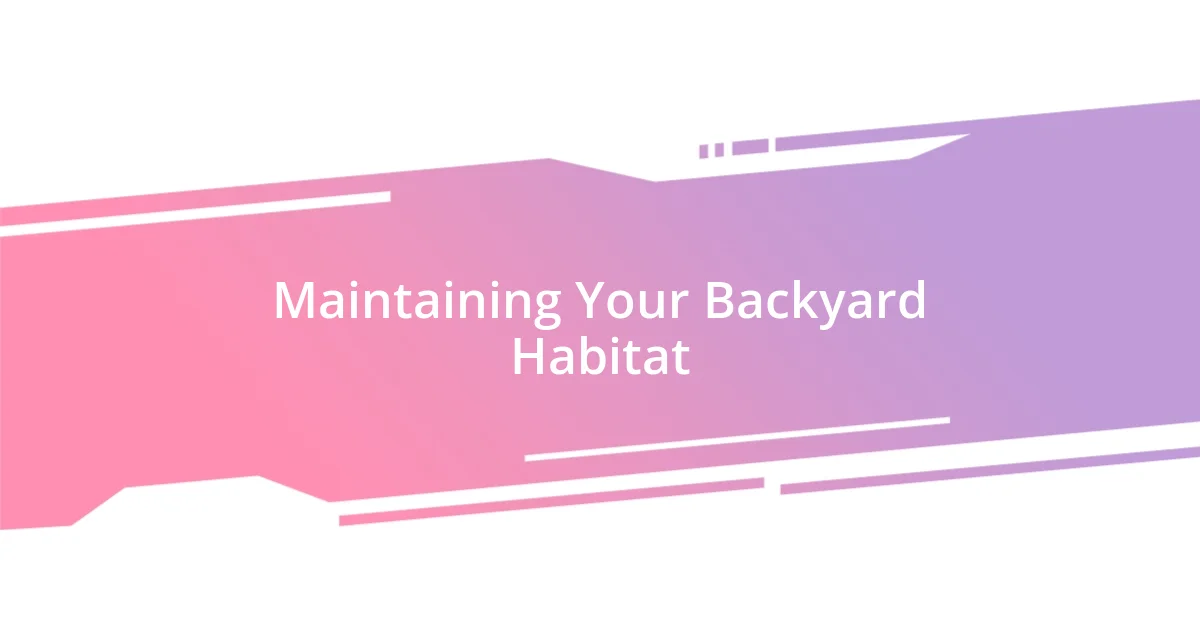
Maintaining Your Backyard Habitat
Maintaining your backyard habitat requires ongoing dedication and a bit of creativity. Personally, I’ve found that regular monitoring is essential. For instance, I pay close attention to the plants I chose for their native characteristics. If I notice any invasive species creeping in, like weeds that try to take over, I grab my gardening gloves and tackle them right away. Isn’t it fascinating how a little vigilance can keep your entire habitat thriving?
On a more emotional note, I’ve learned that seasonal changes bring a whole new aspect of care. As the fall approaches, I like to leave some leaf litter on the ground. To many, this may seem like a chore to clean up, but my perspective shifted when a family of hedgehogs made it their home one cold winter night! Witnessing the cycle of life through such small acts reminds me that every decision impacts my backyard ecosystem. When was the last time you saw nature’s resilience right outside your window?
Lastly, I can’t stress enough how beneficial it is to engage with the wildlife you attract. By keeping a journal of my observations, I track which species visit and how often. This simple practice not only enhances my connection to my backyard but also allows me to adapt my habitat maintenance to encourage more visitors. Have you ever noticed how keeping records can spark new ideas about what to try next? By actively participating in your habitat’s maintenance, you become part of its story, and each page can unveil new wonders waiting to be discovered.












